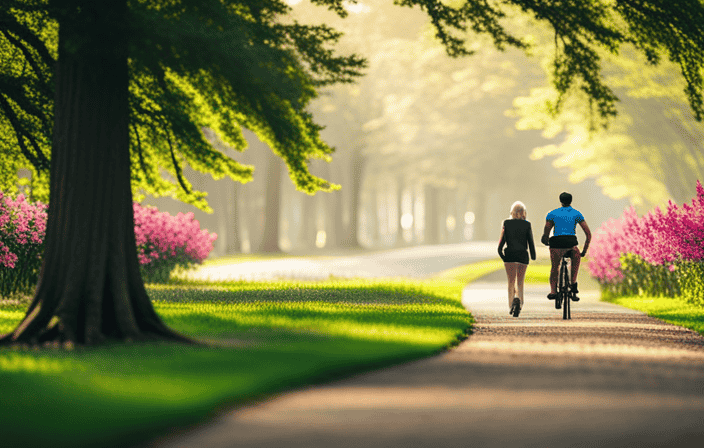Are you feeling exhausted from the never-ending hustle and bustle of daily life? Are you seeking a way to discover peace and tranquility in the midst of all the chaos? Look no further!
In this article, we will explore the incredible benefits of cycling, walking, and relaxation techniques for achieving a stress-free state.
These activities not only provide a physical outlet but also help clear your mind and restore inner peace.
So grab your bike, put on your walking shoes, and get ready to embark on a journey towards tranquility and well-being.
Key Takeaways
- Cycling is an effective exercise for releasing stress and can be done through commuting to work or mountain biking for relaxation.
- Walking is an easy exercise for heart health and can increase blood flow and fresh air in the body.
- Breathing exercises and techniques, such as rhythmic breathing and deep breaths with stomach movement, can help in relaxation and stress relief.
- Progressive muscle relaxation techniques can help in releasing stress and tension from different body parts, promoting relaxation of both the body and mind.
Cycling and Walking
I find cycling to be an effective exercise for releasing stress, especially when I commute to work on my bicycle. Not only does it provide a great cardiovascular workout, but it also allows me to enjoy the fresh air and scenery along the way. Choosing the right bike and shoes is essential for a comfortable and enjoyable ride.
I personally enjoy mountain biking as it provides an extra level of relaxation and stress relief. It allows me to connect with nature and challenge myself physically.
On days when I don’t feel like cycling, I opt for walking, which is the easiest exercise for heart health. Regular walks not only increase blood flow but also provide an opportunity to explore different routes and find motivation to stay active. It’s important to invest in proper shoes for jogging to avoid any discomfort or injuries.
By incorporating cycling, walking, and other exercises into my routine, I have found that I am better able to stay calm and stress-free.
Choosing the Right Gear
Choosing the right gear is essential for maximizing the benefits of exercise and ensuring a comfortable and safe experience. When it comes to cycling and walking, having the right equipment can make all the difference.
Here are three key items to consider:
-
Bicycles: Finding the right bike for your needs is crucial. Whether you’re looking for a road bike, mountain bike, or a hybrid, it’s important to choose one that suits your terrain and riding style. Consider factors such as frame material, bike size, and suspension options.
-
Shoes: Having proper footwear is vital for both cycling and walking. For cycling, clipless shoes with cleats that attach to the pedals can provide better power transfer and efficiency. When it comes to walking, opt for comfortable and supportive shoes that fit well and provide adequate cushioning.
-
Accessories: Don’t forget about accessories that can enhance your cycling and walking experience. Items like helmets, reflective gear, lights, and panniers can improve safety and convenience.
By investing in the right gear, you can ensure that your cycling and walking activities are enjoyable, effective, and stress-free.
Benefits of Regular Exercise
Having the right gear is essential for maximizing the benefits of exercise and ensuring a comfortable and safe experience. Regular exercise offers numerous advantages for both physical and mental well-being. It helps reduce stress, improve mood, boost energy levels, and enhance overall fitness.
Cycling and walking, in particular, are excellent forms of exercise that can be easily incorporated into daily routines. By investing in a good pair of shoes for walking or cycling, you can provide adequate support and cushioning to your feet, reducing the risk of injuries. Additionally, choosing the right bike that suits your body type and cycling preferences can optimize your cycling experience.
With the right gear, you can fully enjoy the benefits of regular exercise, promoting a calm and stress-free lifestyle.
Breathing Exercises
Practicing breathing exercises can significantly improve mental well-being and promote relaxation. Deep breathing techniques, such as rhythmic breathing and deep breaths with stomach movement, help calm the mind and reduce anxiety. Finding a comfortable space for these exercises is essential, as it allows for uninterrupted focus on the breath. Nose breathing technique can also be beneficial, as it helps to regulate the flow of oxygen and carbon dioxide in the body. Another technique, progressive muscle relaxation, involves contracting and relaxing different body parts to release tension. By incorporating stretching exercises and meditation, this relaxation technique can provide a comprehensive stress relief. Regular exercise, including breathing exercises, is crucial for managing stress and achieving a calm state of mind.
| Breathing Exercises | Benefits |
|---|---|
| Rhythmic breathing | Calms the mind and reduces anxiety |
| Deep breaths with stomach movement | Promotes relaxation and stress relief |
| Nose breathing technique | Regulates oxygen and carbon dioxide levels |
| Progressive muscle relaxation | Releases tension and promotes overall relaxation |
| Importance of regular exercise | Crucial for managing stress and achieving a calm state of mind |
Progressive Muscle Relaxation
I find progressive muscle relaxation incredibly effective for releasing tension and promoting overall relaxation. It’s a technique that involves systematically tensing and then relaxing each muscle group in your body. Here are three reasons why I believe progressive muscle relaxation is a valuable tool for managing stress and finding calm:
-
Increased body awareness: By intentionally tensing and releasing different muscle groups, you become more aware of the physical sensations in your body. This heightened awareness can help you identify areas of tension and consciously release them.
-
Stress reduction: Progressive muscle relaxation has been shown to reduce anxiety and stress levels. When you relax your muscles, you also send signals to your brain that it’s safe to let go of stress and tension.
-
Improved sleep quality: Many people find that practicing progressive muscle relaxation before bed helps them unwind and fall asleep more easily. By releasing tension in your body, you create a more relaxed state that is conducive to a restful night’s sleep.
Overall, progressive muscle relaxation is a simple yet powerful technique that can help you find calm and manage stress in your daily life.
Importance of Relaxation
Now that we have explored the technique of progressive muscle relaxation, let’s delve into the importance of relaxation itself.
In today’s fast-paced and demanding world, it can be challenging to find moments of calm amidst the chaos. However, it is crucial to prioritize relaxation as it plays a pivotal role in managing stress and anxiety.
When we are unable to relax, our bodies and minds suffer the consequences, leading to increased tension and decreased well-being. By finding healthy mechanisms for coping with stress, such as meditation techniques and regular exercise, we can effectively calm the mind and promote a sense of tranquility.
Incorporating relaxation into our daily routines is essential for maintaining balance and nurturing our mental and emotional well-being. So, let’s explore various relaxation techniques and discover the transformative power they hold in creating a calm and stress-free life.
Finding Healthy Coping Mechanisms
Exploring different methods of managing stress and anxiety can lead to the discovery of healthy coping mechanisms. It’s important to find ways to relax and calm the mind during stressful situations. One effective way is through meditation techniques, which can help calm the mind and promote relaxation. Regular exercise is also key in managing stress, as it releases endorphins that improve mood and reduce anxiety. Additionally, engaging in hobbies and activities that bring joy and fulfillment can provide a much-needed escape from stress. It’s essential to find what works best for you, whether it’s painting, gardening, or playing a musical instrument. By finding healthy coping mechanisms, we can better navigate stress and maintain a calm and stress-free life.
| Healthy Coping Mechanisms | Benefits |
|---|---|
| Meditation techniques | Calms the mind and promotes relaxation |
| Regular exercise | Releases endorphins and reduces anxiety |
| Engaging in hobbies | Provides an escape from stress and brings joy |
Whole Body Exercise
Engaging in whole body exercises, such as cycling and walking, can contribute to overall well-being and physical health. These exercises not only help in reducing stress but also provide numerous benefits for the body and mind.
When we engage in activities that involve the entire body, we allow ourselves to release tension and promote relaxation. Cycling, for example, not only helps in improving cardiovascular health but also strengthens muscles and joints. Similarly, walking is an easy and accessible exercise that increases blood flow, improves heart health, and provides fresh air.
By incorporating these exercises into our daily routine, we can experience a sense of calm and stress relief. So, grab your bike or put on your walking shoes, and start enjoying the benefits of whole body exercise for a calmer and stress-free life.
Frequently Asked Questions
What are some alternative forms of exercise for stress relief besides cycling and walking?
Some alternative forms of exercise for stress relief include yoga, swimming, and dancing. Yoga combines movement and mindfulness, swimming provides a full-body workout while being low impact, and dancing allows you to let loose and have fun while exercising.
How long should I do breathing exercises for maximum relaxation?
For maximum relaxation, it is recommended to do breathing exercises for at least 10-15 minutes each day. This allows enough time to focus on deep, rhythmic breathing and helps calm the mind and body.
Are there any specific stretches or exercises that can target and relax specific muscle groups?
Yes, there are specific stretches and exercises that can target and relax specific muscle groups. For example, stretching the hamstrings can help relax the muscles in the back of the legs, while shoulder rolls can release tension in the shoulders and neck.
Can relaxation techniques help with anxiety disorders?
Yes, relaxation techniques can help with anxiety disorders. Deep breathing exercises, progressive muscle relaxation, and meditation can all help calm the mind and reduce anxiety symptoms. Regular exercise is also important for managing stress and anxiety.
What are some other healthy coping mechanisms for managing stress besides exercise and relaxation techniques?
In addition to exercise and relaxation techniques, I find that engaging in hobbies and activities that bring me joy, such as painting, playing a musical instrument, or spending time in nature, helps me manage stress.









